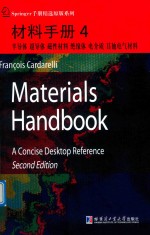

材料手册 4 半导体 超导体 磁性材料 绝缘体 电介质 其他电气材料PDF格式文档图书下载
- 购买点数:19 点
- 作 者:(美)卡达雷利主编
- 出 版 社:哈尔滨:哈尔滨工业大学出版社
- 出版年份:2014
- ISBN:9787560344508
- 标注页数:656 页
- PDF页数:217 页
5 Semiconductors 455
5.1 Band Theory of Bonding in Crystalline Solids 455
5.2 Electrical Classification of Solids 456
5.3 Semiconductor Classes 457
5.3.1 Intrinsic or Elemental Semiconductors 457
5.3.2 Doped Extrinsic Semiconductors 458
5.3.3 Compound Semiconductors 459
5.3.4 Grimm-Sommerfeld Rule 459
5.4 Concentrations of Charge Carriers 460
5.5 Transport Properties 461
5.5.1 Electromigration 461
5.5.2 Diffusion 462
5.5.3 Hall Effect 462
5.6 Physical Properties of Semiconductors 463
5.7 Industrial Applications and Uses 463
5.8 Common Semiconductors 463
5.8.1 Silicon 463
5.8.2 Germanium 469
5.8.3 Boron 470
5.8.4 Other Semiconductors 471
5.9 Semiconductor Wafer Processing 471
5.9.1 Monocrystal Growth 472
5.9.2 Wafer Production 473
5.10 The P-N Junction 475
5.11 Further Reading 475
6 Superconductors 477
6.1 Description and General Properties 477
6.2 Superconductor Types 478
6.2.1 Type Ⅰ Superconductors 478
6.2.2 Type Ⅱ Superconductors 480
6.2.3 High-critical-temperature Superconductors 481
6.2.4 Organic Superconductors 482
6.3 Basic Theory 482
6.4 Meissner-Ochsenfeld Effect 483
6.5 History 483
6.6 Industrial Applications and Uses 485
6.7 Further Reading 485
7 Magnetic Materials 487
7.1 Magnetic Physical Quantities 487
7.1.1 Magnetic Field Strength and Magnetomotive Force 487
7.1.2 Magnetic Flux Density and Magnetic Induction 488
7.1.3 Magnetic Flux 489
7.1.4 Magnetic Dipole Moment 490
7.1.5 Magnetizability,Magnetization,and Magnetic Susceptibility 491
7.1.6 Magnetic Force Exerted on a Material 492
7.1.7 Magnetic Force Exerted by Magnets 493
7.1.8 Magnetic Energy Density Stored 493
7.1.9 Magnetoresistance 494
7.1.10 Magnetostriction 494
7.1.11 Magnetocaloric Effect 495
7.1.12 SI and CGS Units Used in Electromagnetism 498
7.2 Classification of Magnetic Materials 498
7.2.1 Diamagnetic Materials 499
7.2.2 Paramagnetic Materials 500
7.2.3 Ferromagnetic Materials 501
7.2.4 Antiferromagnetic Materials 503
7.2.5 Ferrimagnetic Materials 504
7.3 Ferromagnetic Materials 504
7.3.1 B-H Magnetization Curve and Hysteresis Loop 504
7.3.2 Eddy-Current Losses 506
7.3.3 Induction Heating 507
7.3.4 Sofi Ferromagnetic Materials 507
7.3.5 Hard Magnetic Materials 510
7.3.6 Magnetic Shielding and Materials Selection 512
7.4 Industrial Applications of Magnetic Materials 516
7.5 Further Reading 516
8 Insulators and Dielectrics 519
8.1 Physical Quantities of Dielectrics 519
8.1.1 Permittivity of Vacuum 519
8.1.2 Permittivity of a Medium 519
8.1.3 Relative Permittivity and Dielectric Constant 520
8.1.4 Capacitance 520
8.1.5 Temperature Coefficient of Capacitance 520
8.1.6 Charging and Discharging a Capacitor 521
8.1.7 Capacitance of a Parallel-Electrode Capacitor 521
8.1.8 Capacitance of Other Capacitor Geometries 521
8.1.9 Electrostatic Energy Stored in a Capacitor 522
8.1.10 Electric Field Strength 522
8.1.11 Electric Flux Density 522
8.1.12 Microscopic Electric Dipole Moment 522
8.1.13 Polarizability 523
8.1.14 Macroscopic Electric Dipole Moment 523
8.1.15 Polarization 523
8.1.16 Electric Susceptibility 524
8.1.17 Dielectric Breakdown Voltage 524
8.1.18 Dielectric Absorption 524
8.1.19 Dielectric Losses 525
8.1.20 Loss Tangent or Dissipation Factor 525
8.1.21 Dielectric Heating 526
8.2 Physical Properties of Insulators 526
8.2.1 Insulation Resistance 526
8.2.2 Volume Electrical Resistivity 526
8.2.3 Temperature Coefficient of Electrical Resistivity 527
8.2.4 Surface Electrical Resistivity 528
8.2.5 Leakage Current 528
8.2.6 SI and CGS Units Used in Electricity 529
8.3 Dielectric Behavior 530
8.3.1 Electronic Polarization 530
8.3.2 Ionic Polarization 531
8.3.3 Dipole Orientation 531
8.3.4 Space Charge Polarization 531
8.3.5 Effect of Frequency on Polarization 531
8.3.6 Frequency Dependence of the Dielectric Losses 532
8.4 Dielectric Breakdown Mechanisms 532
8.4.1 Electronic Breakdown or Corona Mechanism 533
8.4.2 Thermal Discharge or Thermal Mechanism 533
8.4.3 Internal Discharge or Intrinsic Mechanism 533
8.5 Electrostriction 533
8.6 Piezoelectricity 534
8.7 Ferroelectrics 534
8.8 Aging of Ferroelectrics 538
8.9 Classification of Industrial Dielectrics 538
8.9.1 Class Ⅰ Dielectrics or Linear Dielectrics 538
8.9.2 Class Ⅱ Dielectrics or Ferroelectrics 539
8.10 Selected Properties of Insulators and Dielectric Materials 539
8.11 Further Reading 542
9 Miscellaneous Electrical Materials 543
9.1 Thermocouple Materials 543
9.1.1 The Seebeck Effect 543
9.1.2 Thermocouple 544
9.1.3 Properties of Common Thermocouple Materials 545
9.2 Resistors and Thermistors 548
9.2.1 Electrical Resistivity 548
9.2.2 Temperature Coefficient of Electrical Resistivity 548
9.3 Electron-emitting Materials 552
9.4 Photocathode Materials 553
9.5 Secondary Emission 554
9.6 Electrolytes 555
9.7 Electrode Materials 556
9.7.1 Electrode Materials for Batteries and Fuel Cells 556
9.7.2 Intercalation Compounds 559
9.7.3 Electrode Materials for Electrolytic Cells 561
9.7.3.1 Industrial Cathode Materials 563
9.7.3.1.1 Low-Carbon Steel Cathodes 563
9.7.3.1.2 Aluminum Cathodes 563
9.7.3.1.3 Titanium Cathodes 564
9.7.3.1.4 Zirconium Cathodes 565
9.7.3.1.5 Nickel Cathodes 565
9.7.3.1.6 Mercury Cathode 565
9.7.3.2 Industrial Anode Materials 565
9.7.3.2.1 Precious-and Noble-Metal Anodes 568
9.7.3.2.2 Lead and Lead-Alloy Anodes 569
9.7.3.2.3 Carbon Anodes 572
9.7.3.2.4 Lead Dioxide(PbO2) 573
9.7.3.2.5 Manganese Dioxide(MnO2) 575
9.7.3.2.6 Spinel(AB2O4)-and Perovskite(ABO3)-Type Oxides 575
9.7.3.2.7 Ebonex?(Ti4O7 and Ti5O9) 576
9.7.3.2.8 Noble-Metal-Coated Titanium Anodes(NMCT) 578
9.7.3.2.9 Platinized Titanium and Niobium Anodes(70/30 Pt/Ir) 579
9.7.3.2.10 Dimensionally Stable Anodes(DSA?)for Chlorine Evolution 580
9.7.3.2.11 Dimensionally Stable Anodes(DSA?)for Oxygen 581
9.7.3.2.12 Synthetic Diamond Electrodes 585
9.7.4 Electrodes for Corrosion Protection and Control 586
9.7.4.1 Cathodes for Anodic Protection 586
9.7.4.2 Anodes for Cathodic Protection 587
9.7.5 Electrode Suppliers and Manufacturers 589
9.8 Electrochemical Galvanic Series 590
- 《材料手册 4 半导体 超导体 磁性材料 绝缘体 电介质 其他电气材料》(美)卡达雷利主编 2014
- 《材料手册 4 半导体 超导体 磁性材料 绝缘体 电介质 其他电器材料 英文版》(美)FrancoisCardarelli著 2014
- 《电工电子工程材料》李宝让编 2012
- 《电子材料与器件原理 下 应用篇》(加)萨法·卡萨普(S.O.Kasap)著 2009
- 《电介质材料及其介电性能》(法)R.科埃略(Roland Coelho),(法)B.阿拉德尼兹(Bernard Aladenize)著;张冶文,陈玲译 2000
- 《基于分子模拟的典型绝缘材料介电特性研究》谢小军著 2017
- 《电子材料与器件原理 上 理论篇 原书第3版》(加)萨法·卡萨普(S·O·Kasap)著 2009
- 《半导体材料 第3版》杨树人,王宗昌,王兢主编著 2013
- 《实用电工材料手册》邱立功著 2010
- 《现代电子材料与元器件》王巍,冯世娟,罗元主编 2012
- 《材料手册8 气体、液体 英文》(美)卡达雷利主编 2017
- 《材料手册1 材料的性能》(美)卡达雷利主编 2017
- 《重新平衡亚洲发展 从中国经济的视角》(美)阿罗拉,(美)卡达雷利编 2013
- 《材料手同 6 矿物 矿石 宝石 岩石 陨石》(美)卡达雷利主编 2014
- 《材料手册 3 不常用的有色金属》(美)卡达雷利著 2014
- 《材料手册7 土壤、肥料、水泥、混凝土、石材、结构材料、林木、燃料、推进剂、炸药、复合材料 英文》(美)卡达雷利主编 2017
- 《材料手册 4 半导体 超导体 磁性材料 绝缘体 电介质 其他电气材料》(美)卡达雷利主编 2014
- 《奇妙的人体》(美)凯思林·雷利著;(美)肖恩·布雷利插画;胡婧译 2015
- 《Materials handbook: a concise desktop reference 2nd Edition=材料手册 2 常用的有色金属及其合金》(美) 卡达雷利(Fran?ois Cardarelli)主编 2014
- 《能源法精要》(美)约瑟夫·P.托梅因(Joseph P.Tomain),(美)理查德·D.卡达希(Richard D.Cudahy)著 2016
